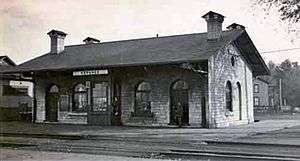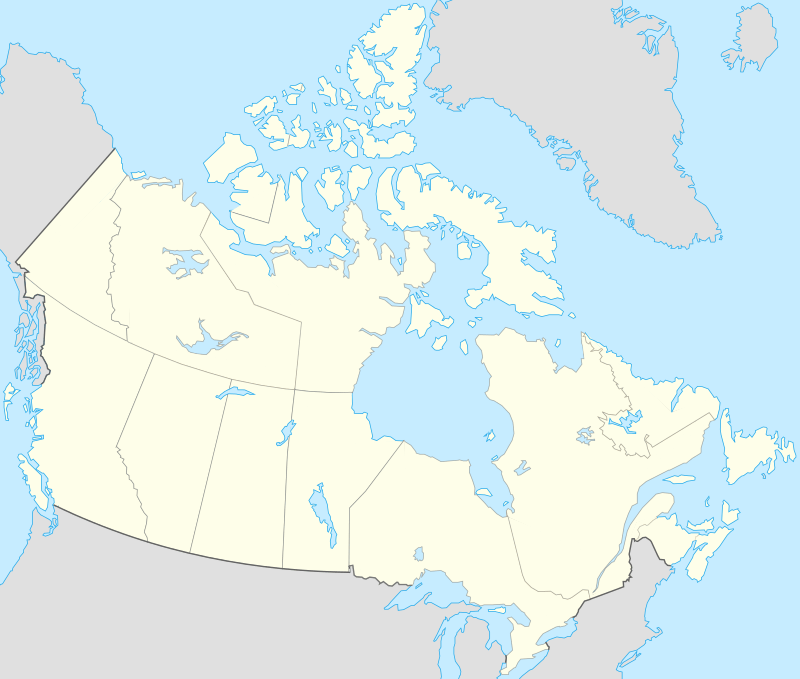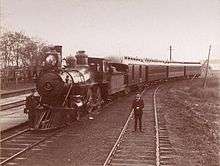Napanee station
Napanee railway station in Napanee, Ontario, Canada is served by Via Rail trains running from Toronto to Ottawa and Montreal. The 1856 limestone railway station is an unstaffed but heated shelter with telephones and washrooms, which opens at least half an hour before a train arrives. The shelter and platform are wheelchair-accessible.
Napanee | |||||||||||||||
|---|---|---|---|---|---|---|---|---|---|---|---|---|---|---|---|
 Napanee station building in the early 1900s | |||||||||||||||
| Location | 301 John Street Napanee, Ontario Canada | ||||||||||||||
| Coordinates | 44°15′13.3″N 76°57′15.5″W | ||||||||||||||
| Platforms | 1 side platform | ||||||||||||||
| Tracks | 2 | ||||||||||||||
| Construction | |||||||||||||||
| Structure type | Shelter | ||||||||||||||
| Parking | Yes | ||||||||||||||
| Disabled access | Yes | ||||||||||||||
| Other information | |||||||||||||||
| Website | Napanee train station | ||||||||||||||
| Services | |||||||||||||||
| |||||||||||||||
| Location | |||||||||||||||
 Napanee station Location within Ontario  Napanee station Location within Canada  Napanee station Location within North America | |||||||||||||||
Napanee station is one of originally 34 first generation Grand Trunk Railway stations in Ontario from the same era as the opening of the line. Nine still exist, of which three remain in active service. The station building is owned and maintained by the municipality.[1]
Railway services
As of early May 2020, Napanee station is served by two domestic routes (with connections). Departures have been reduced to one per day in either direction due to the coronavirus pandemic (effective March 31, 2020).[2]
Ottawa - Toronto Route
| Train | Operator | From | Via | To | Freq. | Service |
|---|---|---|---|---|---|---|
|
44 |
Via Rail | Toronto | Guildwood - Oshawa - Port Hope - Cobourg - Trenton Junction - Belleville - Napanee - Kingston - Gananoque - Brockville - Smiths Falls - Fallowfield | Ottawa | 1/day |
|
|
53 |
Via Rail | Ottawa | Fallowfield - Smiths Falls - Brockville - Gananoque - Kingston - Napanee - Belleville - Trenton Junction - Cobourg - Port Hope - Oshawa - Guildwood | Toronto | 1/day |
|
Montreal - Toronto Route
| Train | Operator | From | Via | To | Freq. | Service |
|---|---|---|---|---|---|---|
|
63 |
Via Rail | Montreal | Toronto | 1/day |
| |
|
66 |
Via Rail | Toronto | Guildwood - Oshawa - Port Hope - Cobourg - Trenton Junction - Belleville -Napanee - Kingston - Gananoque - Brockville - Cornwall - |
Montreal | 1/day |
|
History

The original Grand Trunk stations were stone buildings constructed during or immediately after the 1856 opening of the GTR (now CN) mainline from Montréal to Toronto. Nine survive today, including a pair at Napanee and Ernestown in Lennox and Addington County which were built from Kingston Limestone using similar design. The first generation "Type C" Grand Trunk stations (small stations in Napanee, Ernestown, Brighton) were stone rectangular buildings with four chimneys and five bays for arched windows on the long side and two on each end, under a pitched slate roof with elongated eaves and soffits supported by end rafters and triangular brackets.[4]
At the time of the railway's construction, Bath, Ontario was a bustling lakefront manufacturing village with 400-1000 people. The rails led to a shift in population from Bath (which was not on the GTR mainline) to Napanee (well served by the York Road, Napanee River and Grand Trunk Railway). The railway also led to a shift in population away from small towns to larger centres such as Belleville and Kingston.
At one point, Napanee was served by two railways; the Grand Trunk (Montréal-Toronto) and the Bay of Quinte Railway (Deseronto-Sydenham). The BQR was integrated into Canadian Northern Railway's mainline to Smiths Falls in 1910 and became part of CN when CNoR went bankrupt in 1918. The last fragment of this line was disconnected in 2010 at Napanee's historic Grand Trunk station;[5] it crossed Hwy 401 to a Goodyear Tire and Rubber factory as a dead end after the rails to Smiths Falls were removed in the 1980s. The section from Strathcona to Smiths Falls is now the Cataraqui Trail.
Napanee's station is now municipally owned and remains in active use. The train no longer stops at Ernestown, leaving a boarded-up but intact CN-owned station in a rural area at an inaccessible point on the CN mainline 500 metres (1,600 ft) west of Camden East Road. The other seven stations from this original set are CN-owned and in varying condition. Trains no longer stop at St. Marys Junction, Brighton and Prescott. Kingston's historic outer station, in use until 1974, is now abandoned and in ruins. Belleville's original station is intact but largely vacant as a new facility was built adjacent in 2012. The original Port Hope (1856) and Georgetown (1858) stations remain in active service.
With the exception of the removal of stone chimneys on the four corners, the exterior currently looks much as it did originally. The 1856 Napanee Station was provincially designated Feb 26, 1993[6] under Part 4 of the Ontario Heritage Act; Brighton Station obtained a similar designation in 2000.[7] The other seven original stations are designated federally under the Heritage Railway Stations Protection Act, a status which does not apply to the municipally-owned Napanee station as the railway no longer directly owns the building.[8]
References
- Beale, Charles (2012-10-17). "The transformation of a train station". NapneeGuide.com. Archived from the original on 2014-05-20.
- Via Rail - Current advisories Updated: April 23, 2020 - 11:30AM
- "Temporary Schedule" (PDF). Via Rail Canada. Retrieved 2020-04-24.
- "RSR-89: CNR — Ernestown, Ontario". Historic Sites and Monuments Board of Canada. 1991-09-11. Retrieved 2013-09-25.
- "CN's Millhaven Spur". Trackside Treasure. 2010-09-28.
- "Property Information - Napanee rail station". Ontario Heritage Properties Database. Archived from the original on 2013-09-27. Retrieved 2013-09-25.
- "Property Information - Brighton rail station". Ontario Heritage Properties Database. Archived from the original on 2013-09-27. Retrieved 2013-09-25.
- "The Heritage Railway Stations Program". Parks Canada - Historic Sites and Monuments Board of Canada. 2011-08-23. Archived from the original on 2013-10-17. Retrieved 2013-09-25.